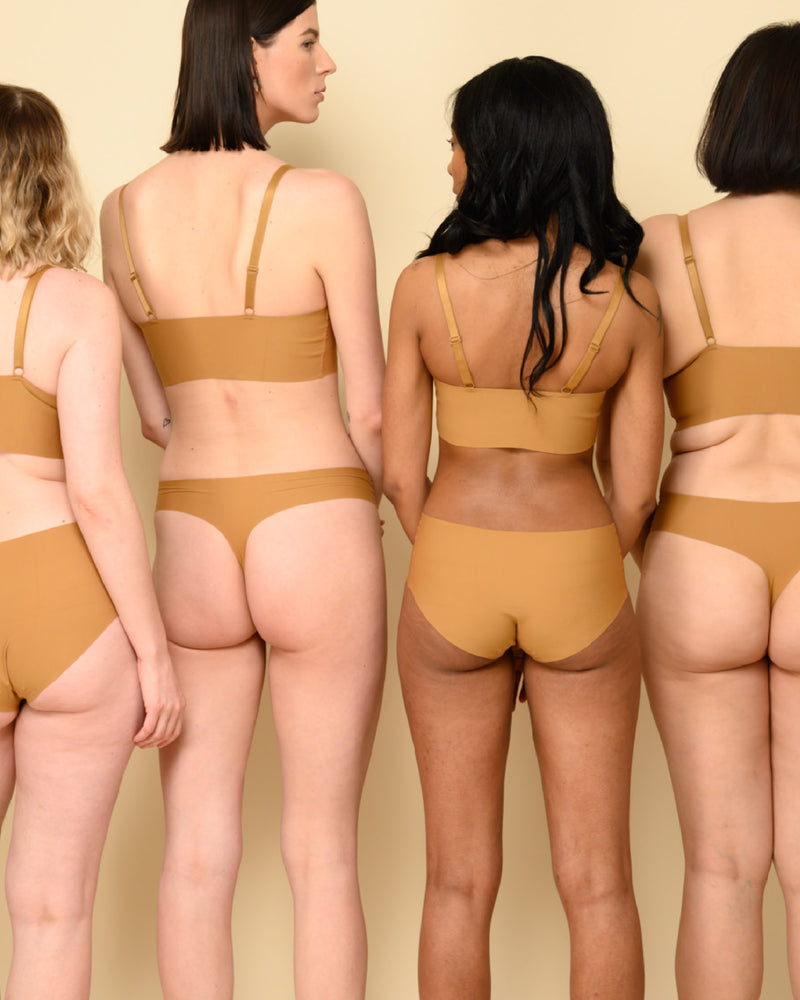The History of Lingerie

As Women’s History Month comes to a close, we wanted to highlight an important historical topic that was never taught in school: the evolution of our undergarments. Let’s be honest: what’s underneath has always counted for more than function. While lingerie has been a polarizing topic for as long as it’s existed, if you look into each of its generational iterations, it’s clear that underlying these trends are cultural and societal commentaries on what a woman’s body should look like and how she should perceive herself.
Refresh your memory on the popular undergarments of the past. While there is certainly more work to do, women are *finally* on the path to reclaiming our own identity in such a way that encourages empowerment over our own narrative as well as embraces diversity in many ways. And, we’re incredibly proud that women-owned and women-run intimates brands, like okko, are leading this change!
1500s–early 1900s: Corsets
Corsets have been romanticized in paintings, photographs, literature, movies, and television, but it’s no secret that they were incredibly uncomfortable. The ultimate goal? Emphasize the breasts and create as small a waist as possible. Women wore various types of corsets for centuries, from stays (fully boned, longline corsets) in the 1700s to the s-curve corset in the 1800s, which emphasized an hourglass figure.
1920s: Slips
With the rise of loose, boxy flapper fashion, there was no need for tight, uncomfortable corsets. Now women wanted their undergarments as invisible as possible, wearing bandeau-type bras meant to deemphasize and flatten the breasts. And with shorter hemlines also came smaller underwear.
1940s: Underwire bras
Underwire bras came back into fashion in the 1940s, including one particular type: the bullet bra. The notoriously exaggerated pointy bra, which allowed women to add a cup size to their measurements, stayed trendy through the 1950s. Hollywood starlets popularized wearing the bras under tight sweaters.
1950s: Corselets and bustiers
Before the 1950s, women were not often photographed in revealing clothing for mass consumption. That all changed with the introduction of the pinup girl motif, who was often photographed and illustrated in flirty lingerie, bathing suits, and dresses. The corselet (a bra and girdles combination) and bustiers, which emphasized the bust, were the undergarments to have.
1960s: No underwear underwear
Goodbye bras! The sexual liberation of the 1960s encouraged women to do away with their restrictive underwire bras. If a woman did decide to go for a bra, it tended to be transparent and minimalist, often with no underwire.
1970s: Sexy lingerie
Lingerie brand Victoria’s Secret was founded in 1977, making sexy lingerie an affordable luxury for middle-class women. The proliferation of its popular stores coincided with the rise of malls as go-to shopping and entertainment hubs across the U.S., and the annual Victoria’s Secret Fashion Show, which ran from 1995 to 2018, garnered millions of viewers to see the models (“Angels”) wear elaborate, fantastical lingerie.
1980s: Underwear becomes outerwear
The 1980s brought a return to classic lingerie styles like bustiers, but also introduced new ones like teddies, or lace bodysuits. Celebrities also continued to popularize the idea that lingerie is meant to be seen, and can even be outerwear.
1990s: Push-up bras
Push-up bras are all the rage, with the Wonderbra perhaps the best example. Still targeting the male gaze, lingerie brands continued to emphasize sex appeal by designing undergarments that emphasize the bust.
2000s: Body-slimming shapewear
Founded in 1998, Spanx popularizes shapewear—bras, underwears, leggings, and other undergarments designed to slim the body down. While industry behemoths like Victoria’s Secret continue to be controlled by men, more women-owned lingerie companies start to pop up.
2010s–now: Made for her, by her
With so many choices, women have more options than ever to find the undergarments that make them feel most comfortable. From bustiers to bralettes, lingerie can be as eye-catching or invisible as you want it. Most importantly, the fashion industry—lingerie included—rightfully starts to focus on diversity and inclusion, particularly in terms of sizing and skin tone. These changes are driven by entrepreneurial women who have started intimates brands seeking to address women’s diverse, multi-faceted needs in particular niches.
Tell us what your favorite type of lingerie is on Instagram @okko.co!
_
ABOUT THE AUTHOR: Haley Kim is a journalist and content creator based in California. Her day job is in the tech industry, but when she's not working you might find her reading a fiction novel, making collages and jewelry, or drinking boba.
